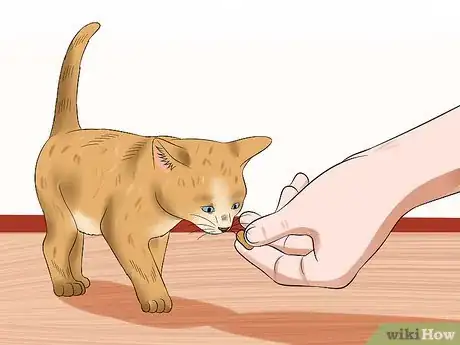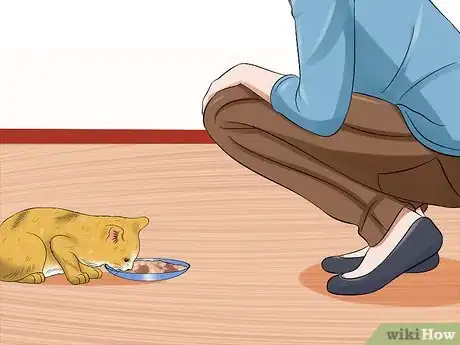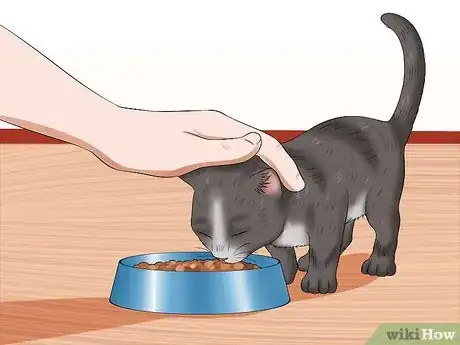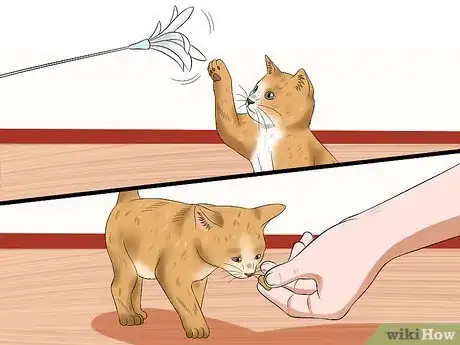This article was co-authored by Molly DeVoss. Molly DeVoss is a Certified Feline Training and Behavior Specialist (CFTBS), a Certified Cat Behavior Consultant (CCBC), a Fear Free Certified Trainer (FFCT), and the Founder of Cat Behavior Solutions. Molly specializes in using positive reinforcement to modify and prevent unwanted behaviors in cats and reduce cat shelter surrender. Molly has sat on the Dallas Animal Advisory committee since 2013 and was voted one of the Top 12 Extraordinary Cat Behaviorists of 2020 by Catpetclub.com. She is certified by both the Animal Behavior Institute and the International Association of Animal Behavior Consultants. She is also the host of the weekly podcast Cat Talk Radio.
There are 16 references cited in this article, which can be found at the bottom of the page.
wikiHow marks an article as reader-approved once it receives enough positive feedback. In this case, several readers have written to tell us that this article was helpful to them, earning it our reader-approved status.
This article has been viewed 25,975 times.
Cats are naturally cautious animals. In addition, a kitten who is not properly socialized during her first 2 to 7 weeks of life can be very timid.[1] [2] If your new kitten is timid, do not be surprised if she immediately seeks out places where she can hide. Be patient and loving towards her as you socialize her and encourage her to be a more confident kitten.
Steps
Setting up a Safe Space for Your Timid Kitten
-
1Select a safe space for your kitten. To a timid kitten, your home probably looks large and scary. Putting her in a small, confined space will help her feel more comfortable and will allow you to socialize her in an area where she feels at ease. Given your kitten’s instinct to run and hide, choose a space with no hiding places, such as a bathroom.[3]
- The bathroom has the added benefit of being a place where people normally go. This will allow your kitten to get accustomed to people, which is an important part of her socialization.[4]
- Other than a bathroom, you could choose another small room that doesn’t have furniture (e.g., couch, bed) that your kitten could easily hide under or behind.[5]
- Make sure the area is quiet—loud noises would startle your kitten.[6]
-
2Make the safe space calm and comfortable for your kitten. Since this small area will be your kitten’s world for a while, it should have everything she needs to feel comfortable. Place her food and water bowls in the room, along with some comfortable bedding, toys, and a box or shelter for her to hide in. Put her litter box in the room and clean it regularly. You could even plug in a cat pheromone diffuser.[7]
- Pheromones are chemicals that animals use to communicate with each other, and can have a calming effect.[8] Cat pheromones are commercially available as spray products and plug-in diffusers at your local pet store. These pheromones can calm your kitten and help her feel less timid.
- Your kitten will need regular veterinary visits, so she will need to get comfortable with her carrier. Place her carrier in the room. Put some comfortable blankets in the carrier and leave its door open so she can explore it whenever she chooses.[9]
Advertisement -
3Play soothing sounds for your kitten. Soothing sounds can help your kitten relax and drown out some of the stressful sounds as the kitten adapts to their new environment. Play classical music or white noise (as opposed to the radio or pop music), which has been shown through research to create a calming environment.
-
4Spend quiet time with your kitten in the small space. This quiet time will be crucial to socializing her and helping her become less timid. How much time you spend with her will probably vary according to how timid she is. In general, aim to spend about 15 to 20 minutes with your kitten, 3 to 5 times a day.[10]
- Before you enter your kitten’s space, knock lightly on the door a few times and call out her name.[11]
- Talk in a soothing voice to your kitten. You could even sing her lullabies![12]
- Try slow blinking with your kitten. Slow blinking communicates friendliness. When she does a slow blink back at you, then you will know she feels safe around you.[13]
- Other than talking quietly with her, you could also read a book or do another quiet activity around her.
- Do not be surprised if your kitten does not want to get anywhere near you at first. Let her approach you on her terms, always.
-
5Continue your normal activities. Your kitten should be comfortable in her space, but that does not mean you should make major changes to your own routine. Make your usual noises so your kitten can become accustomed to the ‘normal life’ sounds in your home.[14] She will come out of the small space eventually, so she will need to be comfortable with the other noises in your home.
Socializing Your Timid Kitten With Food
-
1Choose a scrumptious treat. Kittens may be tiny, but they have huge appetites. Use this to your advantage as you socialize your timid kitten. In fact, food will be your most important tool as you work with your kitten.[15] Other than her regular kitten food, pick some especially tasty foods—tuna, baby food without onion powder or garlic—as treats that you will give her only when you work with her.[16]
-
2Place some food near your kitten. Since your kitten is timid, do not expect her to come to you right away for food. She will probably want to stay back until she feels comfortable enough to approach you. When you sit with her, gently toss a small piece of a treat towards her from a few feet away (depending on the size of her small space). If she eats the treat, continue to toss more treats her way, gradually shortening the distance that you toss it.[17]
- When it’s meal time, place her food bowl a few feet away from you at first. Similar to tossing the treats, gradually shorten the distance between you and the food bowl.[18]
- Try working up to placing the treats or her food bowl in your lap to encourage her to climb into your lap. You could also place some tasty food on your finger to see if she will eat food from your finger.[19]
-
3Stay with your kitten as she eats. Do not give your kitten food and then leave the area. Stay with her until she finishes eating, then take the food away when you leave. Staying with her as she eats is another way for her to become more comfortable with your presence.
- Because your kitten is timid, it may take a few tries before she actually eats in your presence.[20]
-
4Praise your kitten while she eats. Overcoming shyness may be difficult for your kitten. When she is confident enough to be close to you as she eats, reward her for that closeness. As she eats, gently stroke the top of her head and back.
- Stroking your kitten as she eats will help her develop a positive association with you and the food you serve her.
- Give your kitten verbal praise by telling her how brave she is.[21]
Playing With Your Timid Kitten
-
1Select interactive toys for your kitten. Playtime is another important component of socializing your timid kitten. Playing gives you quality time with her, and allows her to get some exercise and challenge herself mentally. Interactive playtime can also build up your kitten’s confidence. Examples of interactive toys include laser lights and wand toys with a small toy attached to the end.
- Ping-pong balls are another good interactive toy, since you can roll them around on the floor and watch your kitten chase them.[22]
- Select a variety of interactive toys.
-
2Let your kitten acclimate to the toys. Whichever toys you choose, set them on the floor and give her time to explore them. Next, slowly pick up one of the toys and gently pet her with it as you did when you stroked her with your hand. This will let her get comfortable with the feel of the toy before you and she start playing with it.[23]
- As you introduce her to new toys, repeat the same acclimation process.
-
3Praise your kitten when she plays with you. Being comfortable enough to play with you will be a big step for your kitten. Make sure you give her plenty of praise so she can continue building up her confidence. In addition, verbal praise will help her make a positive association with playtime.[24]
- Give your kitten treats as you play with her.[25]
- Schedule several play sessions each day and keep them short (5 to 10 minutes).
Expert Q&A
-
QuestionHow do I make my kitten less timid?
 Tabitha KuceraTabitha Kucera is a Registered Veterinary Technician & Cat and Dog Behavior Consultant and the Owner of Chirrups and Chatter Cat and Dog Behavior Consulting and Training in Cleveland, Ohio. Tabitha has over ten years of experience working at animal veterinary hospitals, farm sanctuaries, and cat and dog rescue centers. Tabitha has helped to develop training and behavior programs for various veterinary hospitals and shelters and works as a consultant for many shelters and private veterinary practices. Her teaching credentials include lecturing at regional and national levels and at multiple veterinary technology programs. She is a Fear Free certified speaker, a Fear Free Practice Certification Consultant, a behavior consultant for Cat Pawsitive Pro, and host of the podcast, Tails from a Vet Tech. She currently serves on the board of the Pet Professional Guild’s Cat Committee and is the President of the Society of Veterinary Behavior Technicians. She is an Elite Fear Free and Low-Stress Handling Certified Registered Veterinary Technician, a certified cat behavior consultant, a Karen Pryor Academy certified training partner, and has a Veterinary Technician Specialist (VTS) designation in behavior.
Tabitha KuceraTabitha Kucera is a Registered Veterinary Technician & Cat and Dog Behavior Consultant and the Owner of Chirrups and Chatter Cat and Dog Behavior Consulting and Training in Cleveland, Ohio. Tabitha has over ten years of experience working at animal veterinary hospitals, farm sanctuaries, and cat and dog rescue centers. Tabitha has helped to develop training and behavior programs for various veterinary hospitals and shelters and works as a consultant for many shelters and private veterinary practices. Her teaching credentials include lecturing at regional and national levels and at multiple veterinary technology programs. She is a Fear Free certified speaker, a Fear Free Practice Certification Consultant, a behavior consultant for Cat Pawsitive Pro, and host of the podcast, Tails from a Vet Tech. She currently serves on the board of the Pet Professional Guild’s Cat Committee and is the President of the Society of Veterinary Behavior Technicians. She is an Elite Fear Free and Low-Stress Handling Certified Registered Veterinary Technician, a certified cat behavior consultant, a Karen Pryor Academy certified training partner, and has a Veterinary Technician Specialist (VTS) designation in behavior.
Registered Veterinary Technician & Cat and Dog Behavior Consultant The best way to socialize a kitten is to provide them with a variety of experiences but socialization is a lot more than exposure. It's about exposing them in controlled environments where you're assessing their body language and it's 100% positive. When introducing your cat to your friends and family, let the kitten choose to come up to them. Pair this experience with treats and, if they show signs of conflict or anxiety, have the person step away and continue to get the cat treats.
The best way to socialize a kitten is to provide them with a variety of experiences but socialization is a lot more than exposure. It's about exposing them in controlled environments where you're assessing their body language and it's 100% positive. When introducing your cat to your friends and family, let the kitten choose to come up to them. Pair this experience with treats and, if they show signs of conflict or anxiety, have the person step away and continue to get the cat treats.
Warnings
- Onion and garlic powder are toxic to cats.⧼thumbs_response⧽
- Cat bites scratches can make people sick.[31] Go see your doctor if you start to feel unwell after your kitten scratches or bites you.⧼thumbs_response⧽
- In addition to being timid, a kitten who is not socialized can become aggressive and distrustful.[32]⧼thumbs_response⧽
Expert Interview

Thanks for reading our article! If you'd like to learn more about controlling cats' behavior, check out our in-depth interview with Tabitha Kucera.
References
- ↑ http://www.nycferalcat.org/newsletter/2009-02/shycat.htm
- ↑ http://www.vetstreet.com/our-pet-experts/your-guide-to-socializing-a-kitten
- ↑ http://tenthlifecats.org/all-about-cats/cat-behavior/shy-cat-socialization/setting-up-a-space
- ↑ http://www.nycferalcat.org/newsletter/2009-02/shycat.htm
- ↑ http://www.happycatsanctuary.net/socializing-shy-kittens
- ↑ http://www.catster.com/lifestyle/cat-training-behavior-tips-socializing-shy-cats
- ↑ http://www.catster.com/lifestyle/cat-training-behavior-tips-socializing-shy-cats
- ↑ http://www.peteducation.com/article.cfm?c=1+2174&aid=158
- ↑ http://tenthlifecats.org/all-about-cats/cat-behavior/shy-cat-socialization/setting-up-a-space
- ↑ http://tenthlifecats.org/all-about-cats/cat-behavior/shy-cat-socialization
- ↑ http://www.cats.org.uk/birmingham/caring-for-timid-cats-page
- ↑ http://bestfriends.org/resources/socializing-cats-how-socialize-very-shy-or-fearful-cat
- ↑ https://animalwellnessmagazine.com/3-ways-to-help-with-fear/
- ↑ http://www.cats.org.uk/birmingham/caring-for-timid-cats-page
- ↑ http://www.happycatsanctuary.net/socializing-shy-kittens
- ↑ http://tenthlifecats.org/all-about-cats/cat-behavior/shy-cat-socialization/positive-experiences-with-food
- ↑ http://www.catster.com/lifestyle/cat-behavior-tips-9-ways-transform-scaredy-confident
- ↑ http://www.nycferalcat.org/newsletter/2009-02/shycat.htm
- ↑ http://www.happycatsanctuary.net/socializing-shy-kittens
- ↑ http://tenthlifecats.org/all-about-cats/cat-behavior/shy-cat-socialization/positive-experiences-with-food
- ↑ http://www.catster.com/lifestyle/cat-behavior-tips-9-ways-transform-scaredy-confident
- ↑ http://www.vetstreet.com/our-pet-experts/why-play-is-important-for-kittens?page=2
- ↑ http://tenthlifecats.org/all-about-cats/cat-behavior/shy-cat-socialization/positive-play
- ↑ http://tenthlifecats.org/all-about-cats/cat-behavior/shy-cat-socialization/positive-play
- ↑ http://www.catster.com/lifestyle/cat-behavior-tips-9-ways-transform-scaredy-confident
- ↑ http://tenthlifecats.org/all-about-cats/cat-behavior/shy-cat-socialization
- ↑ http://tenthlifecats.org/all-about-cats/cat-behavior/shy-cat-socialization
- ↑ http://www.catster.com/lifestyle/cat-training-behavior-tips-socializing-shy-cats
- ↑ http://www.catster.com/lifestyle/cat-behavior-tips-9-ways-transform-scaredy-confident
- ↑ http://www.catster.com/lifestyle/cat-training-behavior-tips-socializing-shy-cats
- ↑ http://www.cdc.gov/healthypets/diseases/cat-scratch.html
- ↑ http://www.catster.com/cat-training/cat-socialization
About This Article
To socialize timid kittens, start by creating a small, confined space for your kitten where it will feel comfortable and safe. Introduce petting slowly and always reach from behind when you stroke the kitty to avoid startling it. Sit with your shy kitten while it eats meals and treats, which will help it get used to your presence, and engage it with interactive toys. Providing verbal praise and affection after feedings and play sessions can help to reinforce your positive interactions. For tips from our Veterinary co-author on using soothing sounds to calm the kitten, read on!





































































